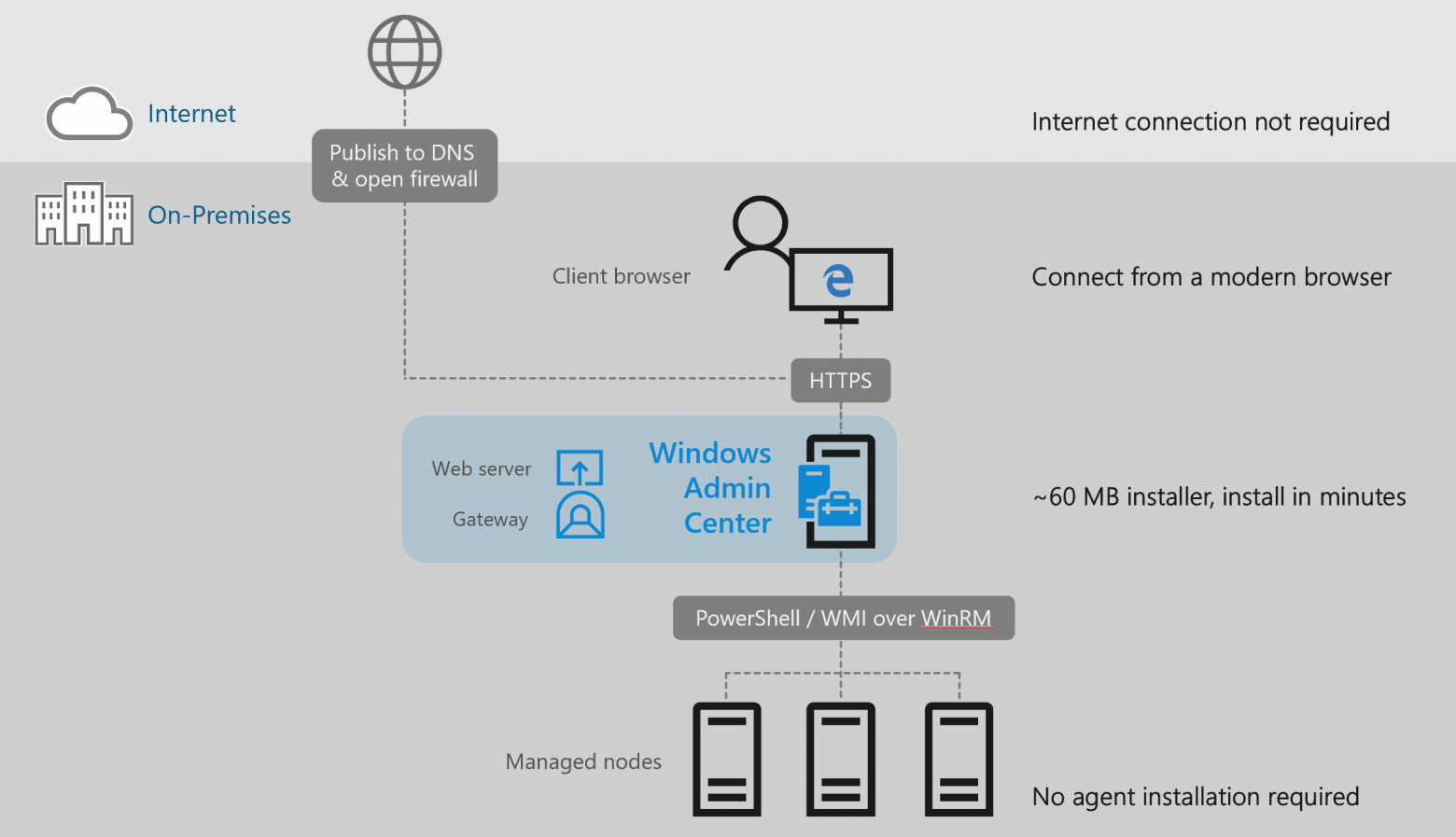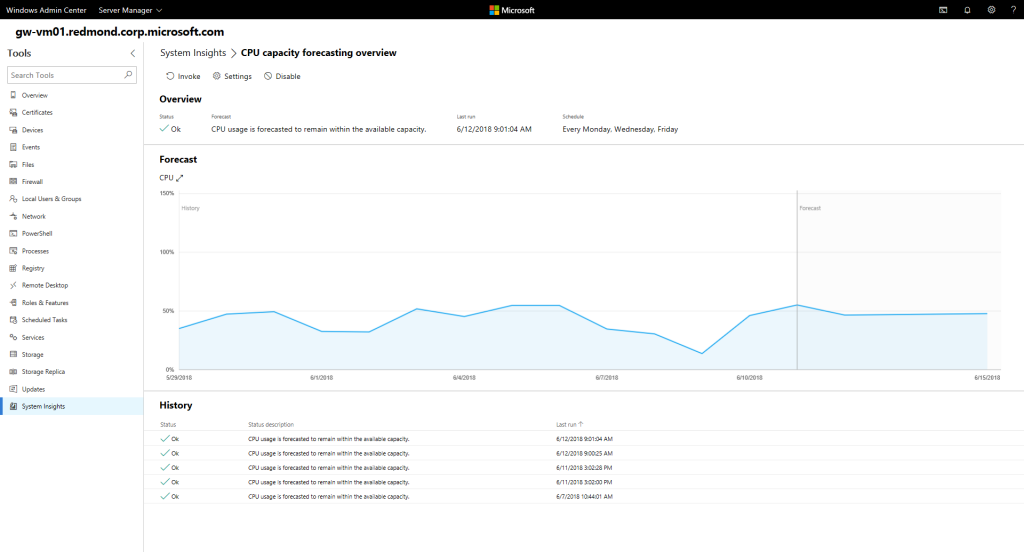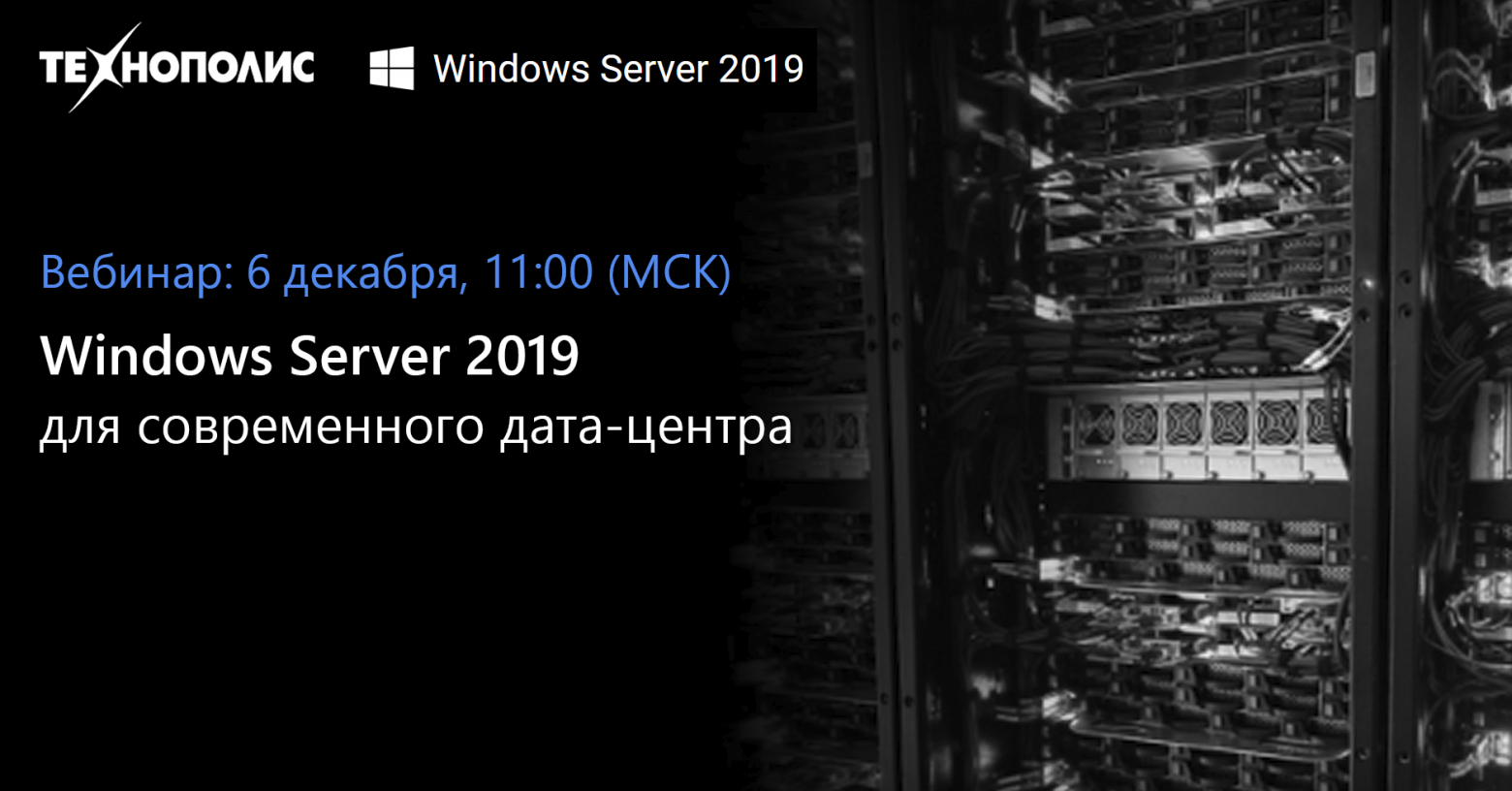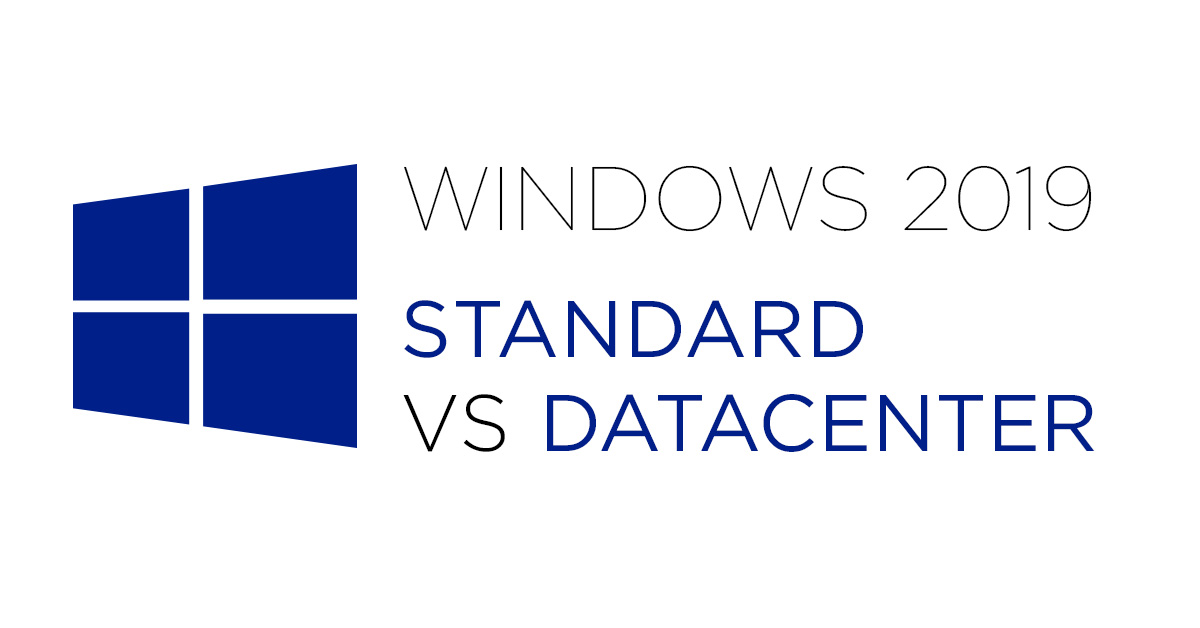Время на прочтение
6 мин
Количество просмотров 129K
История Windows Server насчитывает уже более 25 лет: Windows NT 3.1 Advanced Server был выпущен 27 июля 1993 года. В октябре 2018 года, через три года после предыдущего большого релиза, был выпущен Windows Server 2019. Windows Server 2019 развивает и улучшает возможности, заложенные в предыдущих релизах. Подробности об этом — под катом!
Начиная с Windows Server 2016 был принят новый цикл выхода релизов. Сейчас есть два канала распространения: LTSC (Long-term servicing channel) – релиз, выходящий через 2-3 года, с 5-летней основной и 5-летней расширенной поддержкой, а также Semi-Annual Channel – релизы, которые выходят каждые полгода, имеют основной цикл поддержки в течение 6 месяцев и расширенную поддержку в течение 18 месяцев. Для чего необходимы эти два канала? Microsoft активно внедряет новшества в свою облачную платформу Azure. Это поддержка виртуальных машин Linux, контейнеры с Linux и Windows, и многие другие технологии.
Заказчики, использующие эти технологии в облаке, также хотят их использовать и в своих датацентрах. Semi-Annual Channel сокращает разрыв в возможностях между Azure и локальными датацентрами. Полугодовые релизы предназначены для динамичных в развитии компаний, которые перешли к гибкой сервисной модели предоставления ИТ-услуг бизнесу. Релизы LTSC предназначены для компаний, которые используют устоявшиеся приложения с длительным циклом поддержки, например, Exchange Server, SharePoint Server, SQL Server, а также инфраструктурные роли, программно-определяемые датацентры и гиперконвергентную инфраструктуру.
Windows Server 2019 – это именно релиз в канале LTSC. Он включает в себя все обновления функционала с Windows Server 2016 и последующих полугодовых релизов.
Основные усилия разработчиков Windows Server 2019 были направлены на четыре ключевые области:
- Гибридное облако – Windows Server 2019 и новый центр администрирования Windows Admin Center позволяют легко использовать совместно с серверной операционной системой облачные службы Azure: Azure Backup, Azure Site Recovery, управление обновлениями Azure, Azure AD Authentication и другими.
- Безопасность – является одним из самых важных приоритетов для заказчиков. Windows Server 2019 имеет встроенные возможности для затруднения злоумышленникам проникнуть и закрепиться в системе. Это известные по Windows 10 технологии Defender ATP и Defender Exploit Guard.
- Платформа приложений – контейнеры становятся современным трендом для упаковки и доставки приложений в различные системы. При этом Windows Server может выполнять не только родные для Windows приложения, но и приложения Linux. Для этого в Windows Server 2019 есть контейнеры Linux, подсистема Windows для Linux (WSL), а также значительно снижены объемы образов контейнеров.
- Гиперконвергентная инфраструктура – позволяет совместить в рамках одного сервера стандартной архитектуры и вычисления, и хранилище. Этот подход значительно снижает стоимость инфраструктуры, при этом обеспечивая отличную производительность и масштабируемость.
Windows Admin Center
Windows Admin Center (WAC) – это новое средство администрирования серверов. Устанавливается локально в инфраструктуре и позволяет администрировать локальные и облачные экземпляры Windows Server, компьютеры Windows 10, кластеры и гиперконвергентную инфраструктуру.
WAC дополняет, а не заменяет существующие средства администрирования, такие как консоли mmc, Server Manager. Подключение к WAC осуществляется из браузера.
Для выполнения задач используются технологии удаленного управления WinRM, WMI и скрипты PowerShell.
Можно опубликовать WAC и администрировать серверы извне периметра организации. Службы многофакторной аутентификации и прокси приложений Azure AD помогут защитить такой доступ извне, а использование решения Microsoft Enterprise Mobility + Security (EMS) позволит предоставлять или отказывать в доступе в зависимости от соответствия устройства политикам, рискам, местоположению и другим факторам. Использование веб-приложения вместо доступа к удаленному рабочему для администрирования, по моему мнению, это правильная стратегия для обеспечения безопасности.
Системная аналитика
Windows Server 2019 стал интеллектуальнее. С помощью новой функции System Insights реализуется прогнозная аналитика, позволяющая перейти от реактивного к проактивному управлению парком серверов. Модель машинного обучения учитывает счетчики производительности и события для точного предсказания проблем со свободным местом на дисковой подсистеме, определение трендов для процессорных вычислений, сетевому взаимодействию и производительности хранилища.
Новинки в подсистеме хранения
Storage Migration Service
В Windows Server 2019 появилась новая технология для миграции данных со старых серверов на новые – Storage Migration Service.
Миграция происходит в несколько этапов:
- Инвентаризация данных на различных серверах
- Быстрый перенос файлов, сетевых папок и конфигураций безопасности с исходных серверов
- Захват управления и подмена идентификатора сервера и настроек сети со старого сервера на новый
Управление процессами миграции происходит с помощью Windows Admin Center.
Azure File Sync
Azure File Sync трансформирует традиционные файловые серверы и расширяет объём хранения до практически недостижимых в реальной жизни объёмов. Данные распределяются по нескольким уровням: горячий кэш – это данные, хранящиеся на дисках файлового сервера и доступные с максимальной скоростью для пользователей. По мере остывания данные незаметно перемещаются в Azure. Azure File Sync можно использовать совместно с любыми протоколами для доступа к файлам: SMB, NFS и FTPS.
Storage Replica
Эта технология защиты от катастроф впервые появилась в Windows Server 2016. В версии 2019 появилась ограниченная поддержка редакции Windows Server Standard. Сейчас и небольшие компании могут делать автоматическую копию (реплику) хранилища в виртуальные машины Azure, если в инфраструктуре компании нет второго удаленного датацентра.
Storage Spaces Direct
Локальные дисковые пространства – это необходимый компонент для построения гиперконвергентной инфраструктуры и масштабируемого файл-сервера. В Windows Server 2019 появилась встроенная поддержка энергонезависимой памяти, улучшенные алгоритмы дедупликации, в том числе на томах с файловой системой ReFS, масштабируемость до 4ПБ на кластер, улучшения в производительности.
Изменения в отказоустойчивой кластеризации
Появились наборы кластеров (Cluster sets), увеличивающие масштабируемость до сотен узлов.
Для обеспечения кворума в кластерах с четным количеством узлов используется специальный ресурс – диск-свидетель. Во времена Windows Server 2012 R2 для диска-свидетеля необходимо было выделять диск на хранилище, в Windows Server 2016 стало возможно использовать сетевую папку или облачный диск-свидетель. Улучшения в Windows Server 2019 связаны с сокращением требований к инфраструктуре для малых предприятий. В качестве диска-свидетеля может выступать USB-диск, подключенный, например, к роутеру.
Появилась миграция кластеров между доменами и другие улучшения в службе отказоустойчивой кластеризации.
Что нового в платформе приложений
Теперь можно запускать контейнеры на основе Windows и Linux на одном и том же узле контейнера с помощью одинаковой управляющей программы Docker. Это позволяет работать в разнородной среде узлов контейнеров и предоставить разработчикам гибкость в создании приложений.
Контейнеры получили улучшенную совместимость приложений, значительно был уменьшен размер образов Server Core и Nano Server, повысилась производительность.
Windows Server 2019 получил множество других улучшений. Подробнее ознакомиться с ними можно в разделе Windows Server на официальном сайте документации docs.microsoft.com.
Системные требования
Документация описывает минимальные требования к установке Windows Server 2019. Надо понимать, что в зависимости от ролей и компонентов, от запущенных приложений, требования к серверу могут быть повышены.
- 64-разрядный процессор с тактовой частотой 1,4 ГГц
- Совместимый с набором инструкций для архитектуры х64
- Поддержка технологий NX и DEP
- Поддержка CMPXCHG16b, LAHF/SAHF и PrefetchW
- Поддержка преобразования адресов второго уровня (EPT или NPT)
Минимальные требования к ОЗУ:
- 512МБ (2ГБ для варианта установки «Сервер с рабочим столом»)
Требования к устройствам хранения:
Windows Server 2019 не поддерживает ATA/PATA/IDE и EIDE для загрузки, файла подкачки или дисков с данными. Минимальный объём – 32 ГБ.
Сетевые адаптеры:
- Адаптер Ethernet с пропускной способностью не менее 1ГБ.
- Совместимость со спецификацией архитектуры PCI Express.
- Поддержка протокола удаленной загрузки PXE.
Сравнение выпусков Windows Server 2019 Standard и Datacenter
Windows Server 2019 поставляется в двух редакциях: Standard и Datacenter.
Редакция для датацентров обладает расширенными возможностями: поддержка гиперконвергентной инфраструктуры, локальных дисковых пространств, расширенными лицензионными правами при использовании виртуализации.
Приглашение на вебинар
Подробнее с возможностями Windows Server 2019, сценариях использования, вариантах лицензирования можно будет ознакомиться на вебинаре «Windows Server 2019 для современного датацентра».
Спикер — Дмитрий Узлов, сертифицированный эксперт по решениям Майкрософт с многолетним опытом.
- Microsoft Certified Solutions Expert: Cloud Platform and Infrastructure
- Microsoft Certified Solutions Expert: Productivity
Специалист по кибербезопасности, руководитель направления проектов золотого партнера Майкрософт – компании Технополис
Вебинар пройдет 6 декабря в 11.00, после вебинара вы сможете сделать практические работы по развертыванию виртуальной инфраструктуры Windows Server и настройке типовых сценариев гибридного датацентра. Успешно справившиеся с заданиями практической работы получат электронный сертификат о прохождении тренинга.
Запись вебинара можно посмотреть по ссылке.
Posted By: Jan. 23, 2020
Introduction
Windows Server 2019 is an operating system created by Microsoft and created to run on servers. Servers are specialized computers that usually operate within the client-server network; servers handle requests from the clients on the network. The use of a server operating system can allow other applications to run on the server’s hardware, and this can help fill different server job functions, such as a mail server or print server.
Microsoft Windows Server 2019 is based on the popular Windows Server 2016, and aims to reduce business risk and enhance security through the multiple layers of security and protection embedded in the operating system. One of the difference from the previous versions is the addition of hyper-converged infrastructure (HCI) and Hybrid capabilities with Azure (which provides a number of cloud services like virtual computing, analytics, storage and networking).
Microsoft Windows Server 2019 is available in 2 editions, standard and datacenter. Choosing the right edition is extremely important so you don’t end up buying something which is either incapable of fulfilling your wants, or has unnecessary features which will add to your costs.
Every business has different needs and budget. Read on to know the major differences between the Windows Server 2019 Standard and Datacenter editions.
Windows Server 2019 Standard
Windows Server Standard 2019 is suitable for small and medium businesses, that does not have high virtualisation needs. This edition allows you to use up to 2 Virtual Machines with 1 Hyper-V host for each license. If you want to add 2 more virtual machines, you have to license all the cores in the server again.
Windows Server 2019 Standard enables you to modernize apps quickly, and download them faster, while enhancing the support system. However, this edition allows you to use only Windows containers, but you can use an unlimited number of such containers.
The Standard edition also lacks Host Guardian Hyper-V Support and thus does not ensure that the hoster knows about the Hyper-V hosts. Also, it does not allow you to manage the keys required to start shielded virtual machines.
This Windows Server 2019 Standard edition is also equipped with a Storage Replication; limited to 1 partnership and 1 resource group. It allows the customers to replicate a single volume of data up to 2 TB.
You can activate this edition as a guest only if you are hosted on the Datacenter edition. Also, the Standard edition lacks features like Software-defined Networking (which is responsible for enabling you to manage your network efficiently and monitor and improve its performance) and Storage Spaces Direct (responsible for creating a highly-available software-defined storage at a lower cost through the use of industry-standard servers along with local-attached drives).
Windows Server 2019 Datacenter
The Windows Server Datacenter edition offers the widest range of capabilities and features without a large number of licensing limitations. It allows you to use an unlimited number of virtual machines, with 1 Hyper-V host for each license.
This edition is suitable for businesses demanding advances storage and virtualization, and who have more demanding Information technology needs. It allows you to use all types of containers and does not set any limit to the number of containers that you can use.
The Datacenter edition is equipped with unique product features. One of them is the Host Guardian Hyper-V Support. This enables you to run a trusted software and manage the keys required to start up shielded virtual machines. This also ensures that the enterprise or hosting company is aware of the Hyper-V hosts.
The Windows Server 2019 Datacenter edition also has Storage Replica with no limits on the amount of data or number of volumes. This allows you to replicate or back up all your data for disaster recovery, and ensure smooth functioning of your website.
You can activate this edition either as a guest or as a host. This edition also has the feature of Software-defined networking, which allows you to program the network in a centrally-controlled manner. It also enables you to monitor and improve the network holistically, notwithstanding the network technology.
Another feature is Storage Spaces Direct, which gives incomparable performance and efficiency when it comes to storage of data. It uses industry-standard, highly-available servers to store your data in local-attached drives. All this comes at a price cheaper than the traditional NAS or SAN arrays.
Another advantage of the Datacenter edition is that you can virtualize an unlimited number of Windows Server instances within the physical Windows Server machine.
Comparison of Standard and Datacenter editions of Windows Server 2019**
Locks and Limits
| Maximum number of users | Based on CALs | Based on CALs |
| Maximum SMB connections | 16,777,216 | 16,777,216 |
| Maximum RRAS connections | unlimited | unlimited |
| Maximum IAS connections | 2,147,483,647 | 2,147,483,647 |
| Maximum RDS connections | 65,535 | 65,535 |
| Maximum number of 64-bit sockets | 64 | 64 |
| Maximum number of cores | unlimited | unlimited |
| Maximum RAM | 24 TB | 24 TB |
| Can be used as virtualization guest | Yes; 2 virtual machines, plus one Hyper-V host per license | Yes; unlimited virtual machines, plus one Hyper-V host per license |
| Server can join a domain | yes | yes |
| Edge network protection/firewall | no | no |
| DirectAccess | yes | yes |
| DLNA codecs and web media streaming | Yes, if installed as Server with Desktop Experience | Yes, if installed as Server with Desktop Experience |
Server roles
| Windows Server roles available | Role services | Windows Server 2019 Standard | Windows Server 2019 Datacenter |
|---|---|---|---|
| Active Directory Certificate Services | Yes | Yes | |
| Active Directory Domain Services | Yes | Yes | |
| Active Directory Federation Services | Yes | Yes | |
| AD Lightweight Directory Services | Yes | Yes | |
| AD Rights Management Services | Yes | Yes | |
| Device Health Attestation | Yes | Yes | |
| DHCP Server | Yes | Yes | |
| DNS Server | Yes | Yes | |
| Fax Server | Yes | Yes | |
| File and Storage Services | File Server | Yes | Yes |
| File and Storage Services | BranchCache for Network Files | Yes | Yes |
| File and Storage Services | Data Deduplication | Yes | Yes |
| File and Storage Services | DFS Namespaces | Yes | Yes |
| File and Storage Services | DFS Replication | Yes | Yes |
| File and Storage Services | File Server Resource Manager | Yes | Yes |
| File and Storage Services | File Server VSS Agent Service | Yes | Yes |
| File and Storage Services | iSCSI Target Server | Yes | Yes |
| File and Storage Services | iSCSI Target Storage Provider | Yes | Yes |
| File and Storage Services | Server for NFS | Yes | Yes |
| File and Storage Services | Work Folders | Yes | Yes |
| File and Storage Services | Storage Services | Yes | Yes |
| Host Guardian Service | Yes | Yes | |
| Hyper-V | Yes | Yes; including Shielded Virtual Machines | |
| Network Controller | No | Yes | |
| Network Policy and Access Services | Yes, when installed as Server with Desktop Experience | Yes, when installed as Server with Desktop Experience | |
| Print and Document Services | Yes | Yes | |
| Remote Access | Yes | Yes | |
| Remote Desktop Services | Yes | Yes | |
| Volume Activation Services | Yes | Yes | |
| Web Services (IIS) | Yes | Yes | |
| Windows Deployment Services | Yes* | Yes* | |
| Windows Server Essentials Experience | No | No | |
| Windows Server Update Services | Yes | Yes |
*WDS Transport Server is new to Server Core installations in Windows Server 2019 (also in the semi-annual channel starting with Windows Server, version 1803)
Features
| Windows Server Features installable with Server Manager (or PowerShell) | Windows Server 2019 Standard | Windows Server 2019 Datacenter |
|---|---|---|
| .NET Framework 3.5 | Yes | Yes |
| .NET Framework 4.7 | Yes | Yes |
| Background Intelligent Transfer Service (BITS) | Yes | Yes |
| BitLocker Drive Encryption | Yes | Yes |
| BitLocker Network Unlock | Yes, when installed as Server with Desktop Experience | Yes, when installed as Server with Desktop Experience |
| BranchCache | Yes | Yes |
| Client for NFS | Yes | Yes |
| Containers | Yes (unlimited Windows containers; up to two Hyper-V containers) | Yes (unlimited Windows and Hyper-V containers) |
| Data Center Bridging | Yes | Yes |
| Direct Play | Yes, when installed as Server with Desktop Experience | Yes, when installed as Server with Desktop Experience |
| Enhanced Storage | Yes | Yes |
| Failover Clustering | Yes | Yes |
| Group Policy Management | Yes | Yes |
| Host Guardian Hyper-V Support | No | Yes |
| I/O Quality of Service | Yes | Yes |
| IIS Hostable Web Core | Yes | Yes |
| Internet Printing Client | Yes, when installed as Server with Desktop Experience | Yes, when installed as Server with Desktop Experience |
| IPAM Server | Yes | Yes |
| iSNS Server service | Yes | Yes |
| LPR Port Monitor | Yes, when installed as Server with Desktop Experience | Yes, when installed as Server with Desktop Experience |
| Management OData IIS Extension | Yes | Yes |
| Media Foundation | Yes | Yes |
| Message Queueing | Yes | Yes |
| Multipath I/O | Yes | Yes |
| MultiPoint Connector | Yes | Yes |
| Network Load Balancing | Yes | Yes |
| Peer Name Resolution Protocol | Yes | Yes |
| Quality Windows Audio Video Experience | Yes | Yes |
| RAS Connection Manager Administration Kit | Yes, when installed as Server with Desktop Experience | Yes, when installed as Server with Desktop Experience |
| Remote Assistance | Yes, when installed as Server with Desktop Experience | Yes, when installed as Server with Desktop Experience |
| Remote Differential Compression | Yes | Yes |
| RSAT | Yes | Yes |
| RPC over HTTP Proxy | Yes | Yes |
| Setup and Boot Event Collection | Yes | Yes |
| Simple TCP/IP Services | Yes, when installed as Server with Desktop Experience | Yes, when installed as Server with Desktop Experience |
| SMB 1.0/CIFS File Sharing Support | Installed | Installed |
| SMB Bandwidth Limit | Yes | Yes |
| SMTP Server | Yes | Yes |
| SNMP Service | Yes | Yes |
| Software Load Balancer | Yes | Yes |
| Storage Replica | Yes | Yes |
| Telnet Client | Yes | Yes |
| TFTP Client | Yes, when installed as Server with Desktop Experience | Yes, when installed as Server with Desktop Experience |
| VM Shielding Tools for Fabric Management | Yes | Yes |
| WebDAV Redirector | Yes | Yes |
| Windows Biometric Framework | Yes, when installed as Server with Desktop Experience | Yes, when installed as Server with Desktop Experience |
| Windows Defender features | Installed | Installed |
| Windows Identity Foundation 3.5 | Yes, when installed as Server with Desktop Experience | Yes, when installed as Server with Desktop Experience |
| Windows Internal Database | Yes | Yes |
| Windows PowerShell | Installed | Installed |
| Windows Process Activation Service | Yes | Yes |
| Windows Search Service | Yes, when installed as Server with Desktop Experience | Yes, when installed as Server with Desktop Experience |
| Windows Server Backup | Yes | Yes |
| Windows Server Migration Tools | Yes | Yes |
| Windows Standards-Based Storage Management | Yes | Yes |
| Windows TIFF IFilter | Yes, when installed as Server with Desktop Experience | Yes, when installed as Server with Desktop Experience |
| WinRM IIS Extension | Yes | Yes |
| WINS Server | Yes | Yes |
| Wireless LAN Service | Yes | Yes |
| WoW64 support | Installed | Installed |
| XPS Viewer | Yes, when installed as Server with Desktop Experience | Yes, when installed as Server with Desktop Experience |
| Features available generally | Windows Server 2019 Standard | Windows Server 2019 Datacenter |
|---|---|---|
| Best Practices Analyzer | Yes | Yes |
| Direct Access | Yes | Yes |
| Dynamic Memory (in virtualization) | Yes | Yes |
| Hot Add/Replace RAM | Yes | Yes |
| Microsoft Management Console | Yes | Yes |
| Minimal Server Interface | Yes | Yes |
| Network Load Balancing | Yes | Yes |
| Windows PowerShell | Yes | Yes |
| Server Core installation option | Yes | Yes |
| Server Manager | Yes | Yes |
| SMB Direct and SMB over RDMA | Yes | Yes |
| Software-defined Networking | No | Yes |
| Storage Migration Service | Yes | Yes |
| Storage Replica | Yes, (1 partnership and 1 resource group with a single 2TB volume) | Yes, unlimited |
| Storage Spaces | Yes | Yes |
| Storage Spaces Direct | No | Yes |
| Volume Activation Services | Yes | Yes |
| VSS (Volume Shadow Copy Service) integration | Yes | Yes |
| Windows Server Update Services | Yes | Yes |
| Windows System Resource Manager | Yes | Yes |
| Server license logging | Yes | Yes |
| Inherited activation | As guest if hosted on Datacenter | Can be a host or a guest |
| Work Folders | Yes | Yes |
** Details from Microsoft website at https://docs.microsoft.com/en-us/windows-server/get-started-19/editions-comparison-19
Conclusion
The Windows Server 2019 editions are quite similar in features. The only difference lies in the limits and a few unique product features. While the Standard Edition is suitable for small virtualized environments, the Datacenter edition is perfect for highly virtualized and cloud-based environments.
Standard Windows edition is ideal for small and medium businesses. Thoses that have to deal with their growing Information Technology needs and better web hosting techniques. However, if you want an highly-functional and efficient system to work on, use it on at a large scale, and need a higher degree of virtualization, then the Datacenter edition should be considered. It is the most comprehensive server system launched by Microsoft.
Both Windows edition can be installed as Server Core or with Desktop Experience. The Desktop Experience contains Graphical User Interface (GUI) and is compatible with a variety of applications. Server Core does not have GUI. It needs less RAM, use less disk space and CPU resources, and has a smaller attack surface which offers better resistance to cyber attacks. You should choose the right core, in order to use any edition to its fullest extent.
It is our goal in this article to highlight the most significant distinctions between the Windows Server 2019 Standard and Datacenter versions.
Introduction
For individuals who choose to host their website on a server or in the cloud, the Windows Server operating system was designed just for them. Rather than having to purchase the expensive resources necessary to host a website, the servers act as a middleman, addressing and fulfilling the demands of their clients on their behalf.
Based on the successful Windows Server 2016, Windows Server 2019 helps to eliminate business risk while also enhancing security via the use of several levels of security and protection built into the operating system. Windows Server 2019 is available now. That it comes packed with hyper-converged infrastructure (HCI) and hybrid capabilities with Azure distinguishes it from the previous versions of the software (which provides some cloud services like virtual computing, analytics, storage, and networking).
There are two versions of Microsoft Windows Server 2019, standard and datacenter, that are available. It is critical to select the appropriate edition so that you do not wind up purchasing anything that is either unable to meet your needs or has superfluous features that will increase your expenditures. For example, if the Standard edition is sufficient for your needs and you purchase the Datacenter edition, you will discover that many of the capabilities in Datacenter are really ineffective for your needs, resulting in an unnecessarily higher cost for you.
Every company has its own set of requirements and budget. You are not permitted to purchase an edition only on the basis that another firm uses it. You must first understand the difference between their requirements and your requirements before making your selection. Learn more about the key changes between the Windows Server 2019 Standard and Datacenter versions by continuing to read this article.
Standard edition of Windows Server 2019.
When it comes to small and medium-sized enterprises, the Standard version of Windows Server 2019 is ideal for those that do not require extensive virtualization capabilities. This edition allows you to utilize up to two Virtual Machines with one Hyper-V host per license, with a maximum of two licenses. Adding two more virtual machines requires you to license all of the cores on the server once more, which is expensive.
Windows Server 2019 Standard helps you to modernize programs rapidly and download them more quickly, while also improving the overall support system experience. This edition, on the other hand, permits you to utilize just Windows containers, but you are allowed to use an infinite number of such containers in total.
The Standard version also does not have Host Guardian Hyper-V Support, which means that the hoster will not be aware of the Hyper-V hosts if they use the Standard edition. Furthermore, it does not enable you to control the keys that are necessary to launch shielded virtual machine instances.
Windows Server 2019 Standard Edition includes a Storage Replica, which is limited to one partnership and one resource group in addition to the features listed above. It enables users to replicate a single volume of data of up to 2 terabytes in size.
This version may only be activated as a guest if you are hosted on the Datacenter edition of the server. As a result, technologies such as Software-defined Networking (which is responsible for enabling you to manage your network effectively as well as monitor and enhance its performance) and Storage Spaces Direct are not included in the Standard edition of Windows (responsible for creating highly-available software-defined storage at a lower cost through the use of industry-standard servers along with local-attached drives).
Because it has the broadest variety of capabilities and features without imposing a huge number of license restrictions, the Windows Server Datacenter version is the most popular choice. It enables you to run an infinite number of virtual machines on a single Hyper-V host, with one Hyper-V host per license.
This edition is designed for organizations that require advanced storage and virtualization capabilities, as well as those with more demanding information technology requirements. It allows you to use any sort of container you like and does not place any restrictions on the number of containers you may use at a time.
In addition to its unique product features, the Datacenter version includes Host Guardian Hyper-V support, which is one of the most popular. This enables you to execute trustworthy applications and manage the keys necessary to launch protected virtual machines without fear of compromising your security. The company or hoster will be made aware of the Hyper-V hosts as a result of this action.
Storage Replica is also included in the Windows Server 2019 Datacenter version, and there are no restrictions on the quantity of data or the number of volumes that may be replicated. This enables you to replicate or back up all of your data for disaster recovery purposes, as well as to guarantee that your website runs smoothly.
You have the option of activating this version as a guest or as a host. Additionally, this version has the capability of software-defined networking, which allows you to program the network in a manner that is managed from a central location. It also gives you the ability to monitor and enhance the network in a comprehensive manner, regardless of the network technology used.
It also takes advantage of Storage Spaces Direct, which provides incomparably high performance and efficiency when it comes to data storage and retrieval. It stores your data on local-attached disks on industry-standard, highly available servers, which are managed by the company. All of this is available at a lower cost than typical NAS or SAN arrays, saving you money.
Furthermore, if any server is virtualized in a Datacenter server, the Datacenter host automatically licenses that server, provided that both the guest server and the host are running on the same version of Microsoft Windows.
Conclusion
The characteristics of the various Windows Server 2019 versions are quite similar. The only difference between the two is the set of restrictions and a few unique product features. While the Standard version is suited for situations with just a basic amount of virtualization, the Datacenter edition is suitable for environments with a high level of virtualization and cloud-based environments or datacenters.
Designed for small and medium-sized organizations that are dealing with increasing demands for information technology and better web hosting techniques, the Standard edition is a cost-effective solution. For those who want a highly functional and efficient system to host their website and who require a higher degree of virtualization as well as the ability to operate on a big scale, the Datacenter edition, which is Microsoft’s most comprehensive server system, is recommended.
Following your selection of the edition, you must pick whether you want to purchase the Server Core or the Desktop Experience. The Desktop Experience is the more expensive option. Whereas the Desktop Experience has a Graphical User Interface (GUI) and is compatible with a wide range of programs, the Server Core consumes less RAM, disk space, and CPU and has a smaller attack surface, making it more resistant to cyber-attacks than the Desktop Experience. To make the most of any edition to its maximum potential, you need to select the most appropriate core.
Hardware
Software
|
|
|||||||||||||||||||||||||||||||||||||||||||||||||||||||||||||||||||||||||||||||||||||||||||||||||||||||||||||||||||||||||||||||||||||||||||||||||||||||||||||||||||||||||||||||||||||||||||||||||||||||||||||||||||||||||||||||||||||||||||||||||||||||||||||||||||||||||||||||||||||||||||||||||||||||||||||||||||||||||||||||||||||||||||||||||||||||||||||||||||||||||||||||||||||||||||||||||||||||||||||||||||||||||||||||||||||||||||||||||||||||||||||||||||||||||
© 1992-2020 Майкролэб Инвестмент |

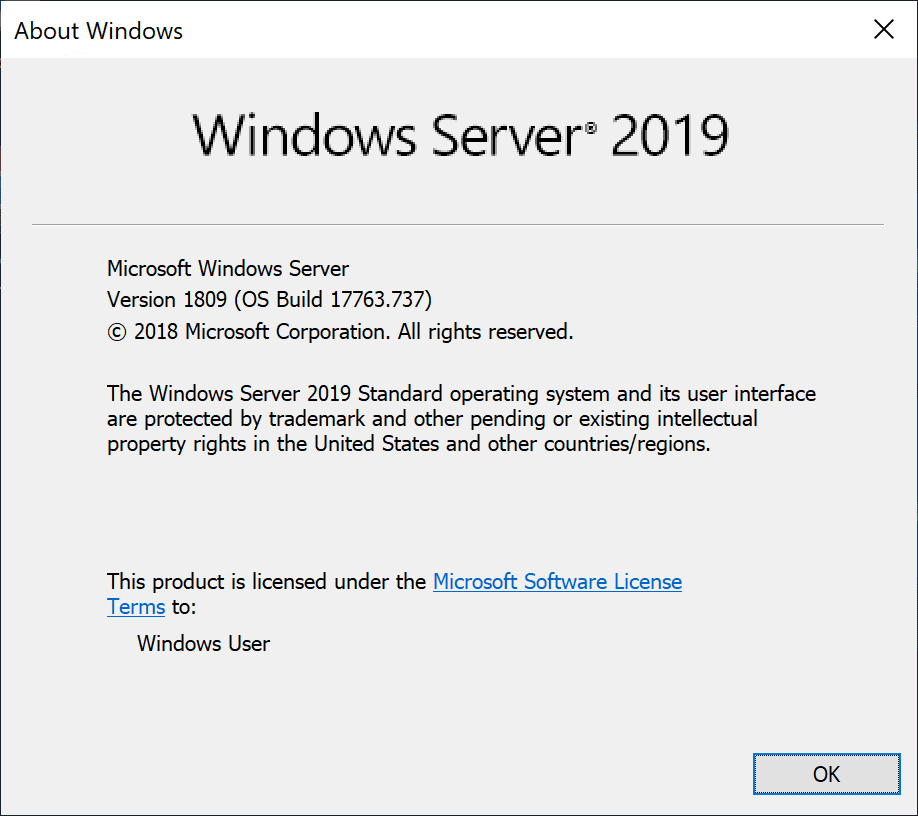
Windows Server 2019 has quickly become the most powerful Windows Server operating system since its release with strong adoption across the board. I know I am using it heavily in my home lab as well as in production environments that I have been a part of. There are various Windows Server 2019 versions for you to choose. Let’s take a closer look at Windows Server 2019 versions comparison and see the different versions to choose from and what features are included with each.
What are the different versions to choose from with Windows Server 2019? A Windows Server 2019 versions comparison offers familiar options for enterprise datacenters looking to install. Rather than listing all of the features between the Windows Server 2019 versions to choose from, let’s concentrate on only the differences as this is generally what set’s each apart.
The following Windows Server 2019 Versions are available for installation:
- Windows Server 2019 Essentials
- Windows Server 2019 Standard
- Windows Server 2019 Datacenter
- Hyper-V Server 2019

Let’s look at each and see what you get with these Windows Server 2019 versions.

Windows Server 2019 Essentials
Windows Server Essentials edition is a cloud-connected Windows Server version designed for small businesses with up to 25 users and 50 devices. Microsoft is highly recommending customers to move to Microsoft 365 instead of Windows Server Essentials.
Windows Server 2019 Essentials has the same licensing and technical characteristics as Windows Server 2016. If you install the Active Directory Domain Services (domain controller) role on Windows Server 2019 Essentials, it must be the only domain controller and cannot have trusts with any other domains.
With Windows Server 2019, Essentials does sport some new hardware support and new functionality like Storage Migration Service, System Insights, and other features.
Windows Server 2019 Standard vs Datacenter
Windows Server 2019 Standard and Datacenter editions are going to be the Windows Server 2019 versions that will be found in most enterprise datacenters. Let’s take a closer look at the main differences in functionality and limitations of Standard edition when compared to Datacenter.
- Virtualization – While Windows Server 2019 Standard can be used as a virtualization guest, it is limited to 2 virtual machines, plus one Hyper-V host per license. Datacenter edition offers unlimited virtual machines plus one Hyper-V host per license.
- Network Virtualization – One of the key roles in Windows Server network virtualization is the Network controller role. Only Datacenter edition offers the Network controller role. Windows Server 2019 Datacenter edition is the only edition that offers Software-defined networking functioanlity.
- Containers – While Windows Server 2019 Standard edition can run unlimited Windows containers, it can only run two Hyper-V containers. Windows Server 2019 Datacenter edition can run unlimited Windows containers AND unlimited Hyper-V containers.
- Hyper-V Security – Using the Host Guardian service, Hyper-V virtual machines can be encrypted. This is only available with Windows Server 2019 Datacenter.
- Storage Replicas – While Windows Server 2019 Standard edition can do Storage Replica, it is limited to 1 partnership and 1 resource group with a single 2 TB volume. Windows Server 2019 Datacenter edition can participate in unlimited Storage Replicas.
- Storage Spaces Direct – The software-defined storage technology in Windows Server 2019 is limited to Windows Server 2019 Datacenter edition. S2D allows you to use locally attached storage that is aggregated into a pool of storage between the members of a Storage Spaces Direct enabled cluster.
- Inherited Activation – While Windows Server 2019 Standard edition can benefit from inherited activation if hosted on Datacenter, Windows Server 2019 Datacenter can be a host or a guest.
Hyper-V 2019 Server
The Hyper-V 2019 Server is a special-purpose Windows Server version that is made for running Hyper-V only. It is a free Windows Server version that essentially competes head-to-head with the free version of VMware’s ESXi free version.
Hyper-V 2019 is essentially Windows Server 2019 Core version with the Hyper-V role preinstalled. However, the major limitation when looking at Hyper-V 2019 is licensing of your guest virtual machines.
While with Windows Server 2019 Standard and Datacenter editions, you get included Windows Server licenses you can run for free on top of those editions, with Hyper-V 2019 Server, you don’t get any guest virtual machine Windows licenses.
This does not mean that all is lost with Hyper-V 2019 Server however. It can potentially make a great fit for Linux VDI or other Linux VM hosting since licensing would not be an issue.
If you are going to run any moderate number of Windows Server VMs on a Hyper-V 2019 Server, it makes sense to potentially bump up to Windows Server 2019 Standard or Windows Server 2019 Datacenter.
Windows Server 2019 GUI vs Core
Windows Server 2019 Core is the first version of Core available in a Windows Server edition that is gaining widespread adoption. This is mainly due to two reasons including Windows Admin Center and Feature on Demand (FoD).
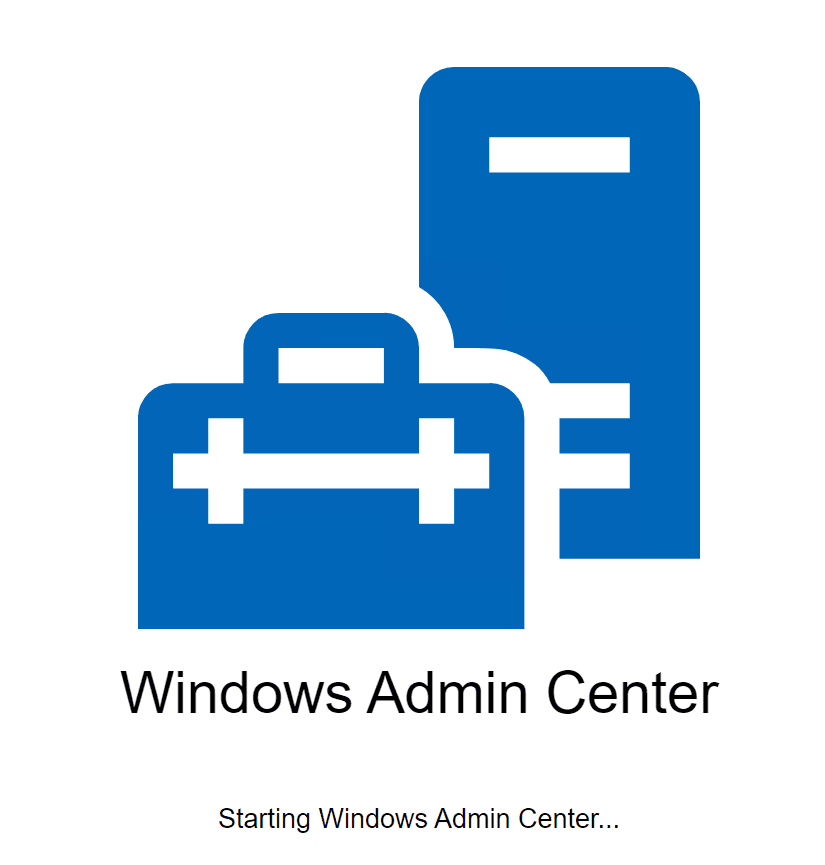
Both of these tools make adopting Windows Server 2019 Core edition extremely feasible and even desirable. For years since the first release of Windows Server Core, Windows Admins have struggled with the available tooling for managing and configuring Windows Server Core. However, this has all changed with WAC and FoD as mentioned.
Now Windows admins have the tools needed to effectively administrate the platform and reap all the security and other benefits that come along with the Core version of the server.
Wrapping Up
In this Windows Server 2019 versions comparison, we have seen the various features and functionality between the respective versions and the use cases they each fit more so than the others.
Understanding the differences can help choose the right version of Windows Server 2019 and achieve the right balance between the features you need and the cost of a license.
Check out our recent blog posts covering Windows Server 2019:
- Windows Server 2019 VMware Snapshot Bug
- Automate Windows Server 2019 Core Installation and Deployment
- Managing Windows Server 2019 Core with Windows Admin Center
- Windows Server 2019 Automating Windows Update with PowerShell and Logs
- Windows Server 2019 Unattended Install Windows Updates

